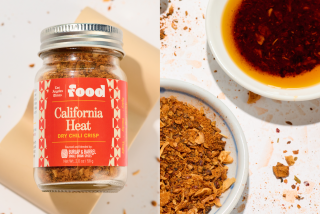Spice Firmâs Tours Soon Only Memory
Visitors walk down memory lane when they tour Friendship Court at the McCormick Spice Co.âs headquarters in Baltimore.
But soon that tour will be only a sentimental memory, because the port cityâs 1921 landmark building is scheduled to be torn down within the next two years to make way for the McCormick Center, a mega-building of offices, a hotel and retail space.
Gone already is that wonderful allspice-clove-cinnamon aroma that once perfumed the air around Baltimore harbor--a casualty of the companyâs decision to transfer production northward to its plant in Hunt Valley, Md.
But if you manage to get there soon, you still find the Light Street headquarterâs Friendship Court, built during the Depression, to be an idealized English street, mostly of the 16th Century, when spices and tea first became widely available in Europe.
The court features several reproductions, including a thatched roof duplicate of the outside of Ann Hathawayâs cottage, a typical clapboard-roofed rural English cottage, Shakespeareâs school house, an early Renaissance house with a replica of the library door of St. Johnâs College, Cambridge and three Tudor structures. Inside are working offices, lounges, meeting rooms and a tea museum.
A Breathtaking View
The glass-walled sensory test kitchen, where recipe development and sampling takes place, is nearby. For many, though, the highlight is the breathtaking view of Baltimoreâs bustling Inner Harbor and the Constellation.
The view is free and so are samples of McCormickâs best. Hostesses in period costumes take tourists to Ye Olde McCormick Tea House, a replica of an early English inn, decorated with an extensive collection of teapots.
There, guests enjoy coffee, tea and (what else?) spice cookies at a replica of the kind of refectory table once used in monasteries and castles.
The walk-in fireplace, with its inglenook for sitting, is emblazoned with the motto of the company founder: âMake the Best, Someone Will Buy It.â
An interior stairway, its mural depicting the history of the transportation of spices, leads to a little theater with walls covered with paintings of âthe romance of spices.â Tourists are treated to a film describing the spice trade--ancient and modern.
Once spices were more valuable than gold, you learn, and peppercorns actually were used as currency. The spicy berries still are the worldâs most commonly consumed seasoning, followed by cinnamon and sesame seeds. Once the luxury of kings, pepper is a necessity almost all of us use.
McCormickâs spice production has changed quite a bit since 1889 when 25-year-old Willoughby M. McCormick founded his company.
The First Tea Bags
It began in a one-room cellar, where he made root beer, fruit syrups and juices, flavoring extracts and nerve and bone liniment and then sold them door-to-door. In 1910, McCormick introduced the first tea bags.
Coast-to-coast distribution came in 1947 with the acquisition of A. Schilling & Co. of San Francisco.
Today, most people still think of spices when they think of McCormick, but the Fortune 500 company calls itself âa diversified speciality food companyâ with 1,300 products and about 300 million customers.
Besides herbs and spices, it produces seasoning mixes, flavorings, dehydrated vegetables, condiments, pourable dressings, cake-decorating products, frozen foods, popcorn and processed poultry products.
These products are produced in 58 facilities worldwide and distributed to food services, food processors and individual consumers in 90 countries.
McCormickâs corps of spice-buying specialists travel to every corner of the globe. Thatâs because many domestic spice crops lack the flavor of wild herbs and spices.
Thus, most of the spices and herbs on the grocerâs shelves--McCormick and otherwise--come from far-flung places.
In years past, the Baltimore plant processed and packaged McCormickâs spices. Today, all processing takes place in the companyâs Hunt Valley plant, just north of Baltimore.
To take a tour of Friendship Court: call (301) 547-6166 for reservations. Tours, lasting 1 1/2 hours, begin at 10 a.m. and 1:30 p.m., Monday through Friday.
What spices do Americans like best? Imports and domestic spices combined to create a U.S. spice consumption for 1987 that totaled 684,292,000 pounds, according to the American Spice Trade Assn. The three leading spices in tonnage for 1987 were mustard seed at 115,506,000 pounds, sesame seed at 80,483,000 pounds and pepper (black and white), 79,136,000 pounds. While this sounds like lots of sprinkling, 60% of our usage was in package foods and restaurant meals.
For help adding spice to your life, hereâs a guide:
ALLSPICE, whole and ground. Description: brown berry with clove-like flavor. Sources: Jamaica, Mexico. Uses: Baked goods, fruit desserts, yellow vegetables, pickles, relishes, marinades.
ANISE SEED, whole and ground. Description: small, greenish-brown seeds; licorice-like taste. Sources: Spain, Turkey, China. Uses: Baked goods, especially cookies and fruit pies. Excellent with poultry and veal.
CARAWAY SEED, whole. Description: Curved brown seeds; warm, tangy taste. Sources: Netherlands, Egypt, Poland. Uses: breads, cheese dips and spreads; sauerkraut, pork or beef casseroles.
CARDAMOM SEED, whole and ground. Description: buff- or green-colored pods containing small brown seeds; strong, exotic aroma. Sources: Guatemala, India. Uses: coffee cakes, cookies, buns; pumpkin and apple pies; hot coffee.
CELERY SEED, whole and ground, also salt. Description: tiny seeds from a special strain of celery, not the same as the vegetable. Sources: India, China. Uses: meat loaves, stews, croquettes, salads, dressings, coleslaw and eggs.
CINNAMON, whole and ground. Description: tan to reddish-brown sticks of rolled bark, with aromatic, sweet pungent taste. Sources: Indonesia, China. Uses: most important baking spice; also puddings, sweet sauces and frozen desserts. Excellent with chocolate, most fruits.
CLOVES, Whole and ground. Description: nail-shaped flower bud and stem with strong, sweet aroma. Sources: Madagascar, Brazil. Uses: whole--pressed into ham and pork; fruit desserts, pickling fruits, stews, root vegetables; ground--baked goods, beverages.
CORIANDER SEED, whole and ground. Description: small, round seed; white to yellowish brown; âperfumed â flavor. Sources: Morocco, Romania, India. Uses: curries, stews; cookies and cakes.
CUMIN SEED, whole and ground. Description: yellowish-brown seeds with strong aroma reminiscent of caraway. Sources: India, China, Turkey, Pakistan. Uses: in chili and curry powders; deviled eggs, soups, sauerkraut, pork, cheese dishes.
DILL SEED, whole. Description: light brown, oval seeds with warm, caraway-like taste. Source: India. Uses: pickles, fish, sauces, cabbage, potatoes, green beans, cauliflower, salad dressings, stuffings.
FENNEL SEED, whole. Description: yellowish-brown seeds with licorice-like aroma. Sources: Egypt, India, China. Uses: chicken, seafood sauces and pork; breads, rolls; sweet vegetables.
GINGER, whole and ground. Description: irregularly shaped pieces of tan-colored roots, with spicy, warm flavor. Sources: China, India, Africa. Uses: ginger ale, gingerbread, cakes, cookies; beef and chicken dishes; sauces, marinades.
MACE, ground. Description: lacy, orange-colored layer from nutmeg fruit. Aroma nutmeg-like, but stronger. Source: Indonesia. Uses: cherry pie, fruitcakes, pound cakes, chowders, creamed spinach or chicken.
MUSTARD SEED, whole and ground (or powdered or dry). Description: tiny seeds, yellowish to reddish-brown. Powder develops sharp, pungent taste when water is added. Sources: Canada, United Kingdom, Denmark, United States. Uses: powdered--cheese dishes, deviled eggs, ham salad, sauces; seed--pickles, salads.
NUTMEG, whole and ground. Description: large brownish seed (nut); sweet, warm aroma and taste. Sources: Indonesia, West Indies. Uses: cakes, cookies, pies, puddings, eggnog, custards, any lemon dessert, corn, creamed spinach, chicken, seafood.
PAPRIKA, ground. Description: rich red powder; slightly sweet taste; some types are nippy. Sources: United States, Spain, Hungary. Uses: the âgarnish spiceâ--also for flavor in creamed, mild-flavored foods such as Welsh rarebit, deviled eggs, sour cream dips, bisques.
BLACK PEPPER, whole (peppercorns), ground, coarse ground and cracked. Description: dark, wrinkled berries; pungent taste. Sources: Brazil, Indonesia, India. Uses: most important spice, used in all kinds of meats and vegetables, some cakes, cookies.
WHITE PEPPER, whole and ground. Description: Light-colored seed of ripe peppercorn; somewhat less pungent. Sources: Indonesia, Brazil, Malaysia. Uses: some as black pepper, but particularly in light-colored sauces, casseroles, soups, eggs, cheese dishes.
RED PEPPER, whole (chiles), ground (cayenne) and crushed. Description: Elongated red pods of varying sizes with heat levels mild to intensively pungent. Sources: India, Mexico, China, United States. Uses: ground or cayenne--dips, sauces, soups, meats, fish; crushed--pizza, spaghetti and various Mexican dishes; whole--pickles and marinades.
POPPY SEED, whole. Description: Tiny, slate blue-colored seeds; nut-like taste. Sources: Netherlands, Australia, Turkey. Uses: as topping for rolls, breads, cookies; in coleslaw, noodles, dips and cheesecake.
SAFFRON, whole and ground. Description: costliest spice; orange-yellow strands (flower stigmas) pleasantly bitter taste. Source: Spain. Uses: so potent, a few strands bring rich, golden color and flavor to rice, chicken, seafood.
SESAME SEED, whole. Description: creamy-white seed with mild, nutty taste. Sources: Mexico, China, Guatemala. Uses: toppings for hamburger buns, breads, cakes, cookies; in stuffings, sauces, vegetable butters, fried chicken coatings. travels
More to Read
Sign up for The Wild
Weâll help you find the best places to hike, bike and run, as well as the perfect silent spots for meditation and yoga.
You may occasionally receive promotional content from the Los Angeles Times.






